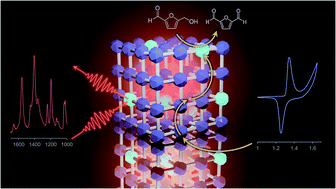Rational incorporation of defects within metal–organic frameworks generates highly active electrocatalytic sites†
Abstract
The allure of metal–organic frameworks (MOFs) in heterogeneous electrocatalysis is that catalytically active sites may be designed a priori with an unparalleled degree of control. An emerging strategy to generate coordinatively-unsaturated active sites is through the use of organic linkers that lack a functional group that would usually bind with the metal nodes. To execute this strategy, we synthesize a model MOF, Ni-MOF-74 and incorporate a fraction of 2-hydroxyterephthalic acid in place of 2,5-dihydroxyterephthalic acid. The defective MOF, Ni-MOF-74D, is evaluated vs. the nominally defect-free Ni-MOF-74 with a host of ex situ and in situ spectroscopic and electroanalytical techniques, using the oxidation of hydroxymethylfurtural (HMF) as a model reaction. The data indicates that Ni-MOF-74D features a set of 4-coordinate Ni–O4 sites that exhibit unique vibrational signatures, redox potentials, binding motifs to HMF, and consequently superior electrocatalytic activity relative to the original Ni-MOF-74 MOF, being able to convert HMF to the desired 2,5-furandicarboxylic acid at 95% yield and 80% faradaic efficiency. Furthermore, having such rationally well-defined catalytic sites coupled with in situ Raman and infrared spectroelectrochemical measurements enabled the deduction of the reaction mechanism in which co-adsorbed *OH functions as a proton acceptor in the alcohol oxidation step and carries implications for catalyst design for heterogeneous electrosynthetic reactions en route to the electrification of the chemical industry.

- This article is part of the themed collections: Metal organic frameworks and porous polymers and Most popular 2021 supramolecular chemistry articles, 2021


 Please wait while we load your content...
Please wait while we load your content...